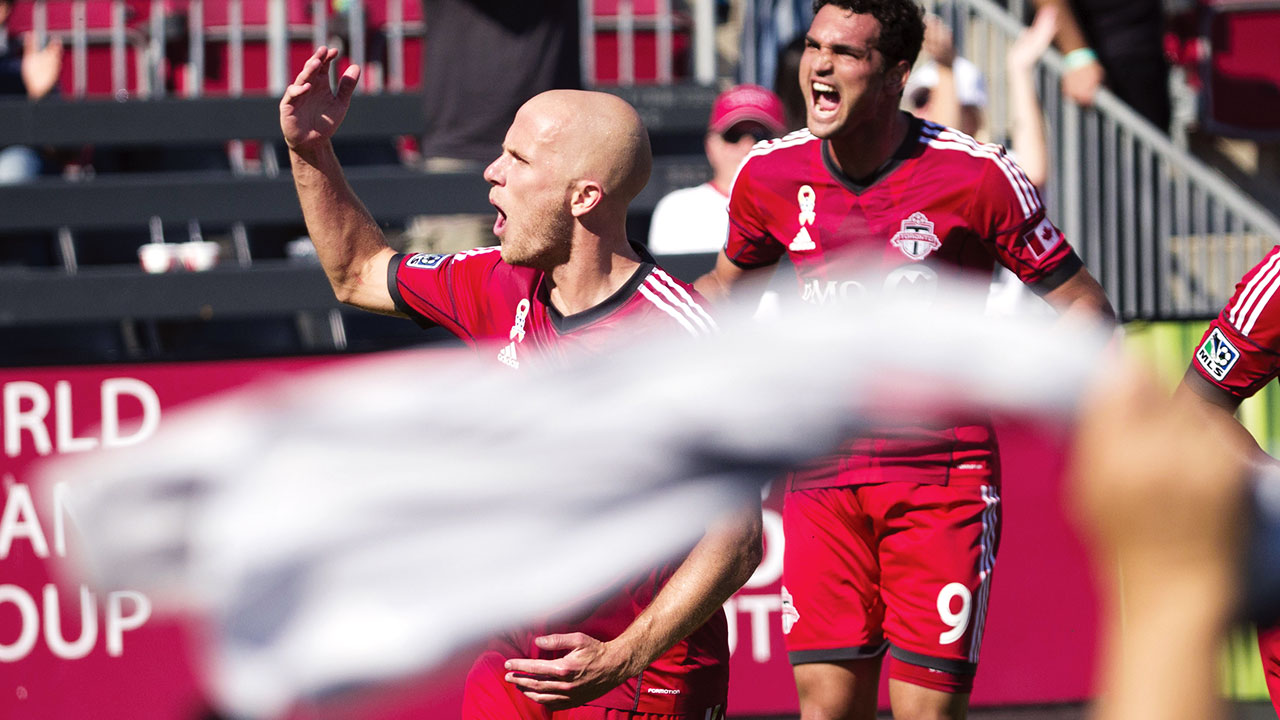It rises above the pitch, beam by beam, a monument to unchecked optimism, long-term vision or maybe just irrational exuberance.
The east grandstand of BMO Field looks fragile against a cold winter sky as workers hustle through the chill to complete the first phase of the $120-million expansion of a stadium that hardly needed it.
The addition of 8,400 permanent seats, bringing the total to 30,000, is ambitious given there were swaths of empty ones last season as TFC limped home well out of the playoffs, the same sad song the franchise has played every year since its inaugural season in 2007.
But spring is coming. Soccer is in the air (at least in North America, where the MLS season runs from March through November, counter to the typical FIFA calendar) and this year—year nine for TFC and, more significantly, year 20 for MLS—is going to be different.
At least Tim Leiweke says so. “We clearly understand: Winning is not about double-decker buses or ad campaigns,” says the outgoing boss of MLSE, who was in charge of heralding last year’s failed signing of Jermain Defoe with double-decker buses and ad campaigns, before the Premier League star became the “Bloody Big” bust. “It’s the hard work that everyone put in the past six months because we got a little salt in the wounds and we were very damned and determined to put this right, once and for all.”
 We’ve ranked the 25 Greatest
We’ve ranked the 25 Greatest
NHL Games Ever Played. Get the free, digital-only edition of Sportsnet magazine on your iOS or Android device right now.
Leiweke hasn’t met an idea he can’t pump up to the point of bursting. Arguably it’s his specialty. But MLS soccer is his favourite child and within the MSLE portfolio of failing sports franchises, TFC is the team that most felt Leiweke could turn around with the force of his charisma and a bottomless pit of money to spend on designated players.
But the challenges faced by the team mirror those of MLS as a whole.
Two decades in, the league seems light years removed from the fragile start-up that required founding shareholders—Robert Kraft, owner of the NFL’s New England Patriots; oil baron Lamar Hunt; and Philip Anschutz, whose company, AEG, is a global sports and entertainment conglomerate on par with Disney—to absorb $350 million (U.S.) in losses, as teams played to crowds of family and friends in otherwise empty American football stadiums. Today there are 20 franchises—bolstered by 2015 expansion clubs in Orlando and New York—and 15 play in soccer-specific, purpose-built stadiums, with more poised to come online. And Leiweke was at the heart of MLS’s last big evolutionary lurch when, in his role with AEG, he lured David Beckham to the L.A. Galaxy.
But as the league grows, its greatest challenge may be weathering its next big step. The 30,000 seats in Toronto are nothing compared to the ambitions of MLS commissioner Dan Garber, who is aiming to have a 24-team league by 2020 and have MLS acknowledged as one of the five best leagues in the world within the next decade.
To get there, MLS will need more players—and good ones—but the league’s very structure could undermine the effort.
By design, MLS set out to avoid the overeager expansion and overspending on players that doomed the old North American Soccer League, the first attempt to make soccer a major-league sport on this continent. MLS is a single-entity operation—the franchises are considered divisions of the same company competing against other sports leagues rather than separate businesses competing with each other. It’s an approach that keeps salaries down (the MLS salary cap was $3.1 million U.S. last season) and competition for players in check. A recent study by the Daily Mail in the U.K. found MLS ranked 22nd in average salary among what it identified as the top 34 professional leagues in the world, even as its average attendance of 19,149 in 2014 (the best in MLS history) sits eighth on the list.
The league is in the first year of a new eight-year television contract with Fox and ESPN; more and more teams own their stadiums and the revenue they generate, and as a group, MLS owners are some of the most powerful figures in sport.
The players have taken note.
The league’s most recent CBA expired on Jan. 31, and—emboldened by the commitment to the cause by the likes of TFC star Michael Bradley—there is talk of
a labour stoppage. “Should we get to a point before the season where things and negotiations aren’t where they should be, we are ready to strike, and we are united as a group to make real progress in terms of the way players get treated in this league,” Bradley told reporters in January.
The players want free agency and better treatment for the rank-and-file—a breakdown of MLS’s wage bill in 2014 by SBNation found that the 13 highest-paid players in 2014 took home 40 percent of the league’s $115 million in wages. Of the league’s 555 players last season, 28 percent were making $50,000 or less.
Meanwhile, as the league has grown, the ambitions of owners like MLSE and those at the helms of the L.A. Galaxy and New York Red Bulls have grown with it, and the teams have used the flex in the salary cap created by the designated-player rule—where teams can pay elite players market rates over-and-above the salary cap—to attract star talent.
In Toronto, that financial might has been used to sign the likes of Bradley and move past the failure that was Defoe to bring other respected internationals on big tickets such as U.S. national-team star Jozy Altidore and Italy’s Sebastian Giovinco.
Leiweke is confident the big names will help turn the new-look BMO Field into a great fit for the fan base. “If we win, we won’t have any problems filling those seats,” he says.
Elsewhere, the expansion Orlando club has inked Brazilian legend Kaka, and New York FC has come to terms with England’s Frank Lampard and Spain’s David Villa.
The influx of talent—thanks to teams spending it like Beckham—is why Leiweke thinks the 20th year of MLS will be a watershed. “I think we’re making the largest leap of any year ever,” he says. “But we’re still young. I think we’ve grown out of puberty, but we’re still a teenager. We’ve come a long way in the past 10 years.”
Big kids, bigger problems.
This story originally appeared in Sportsnet magazine. Subscribe here.










